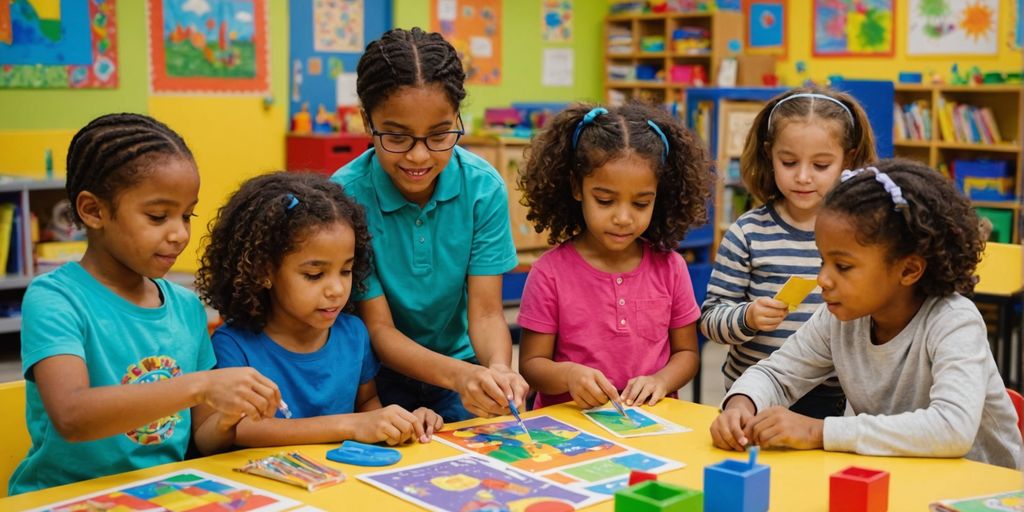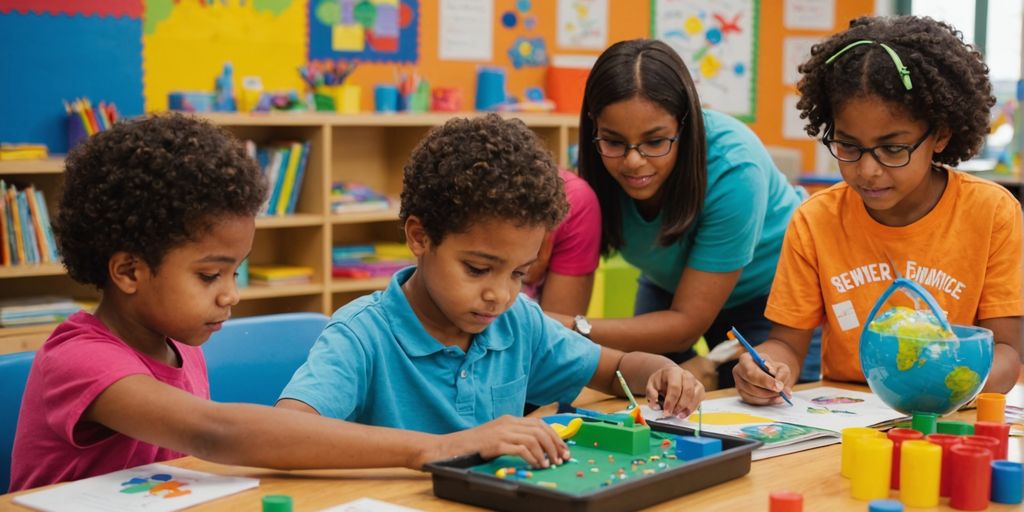
Boosting your child’s learning doesn’t have to be a chore. By engaging them in educational activities that are both fun and informative, you can help them develop new skills and reinforce what they’ve already learned. Here are some top activities that cater to various interests and learning styles, ensuring your child stays engaged and excited about learning.
Key Takeaways
- Reading programs like Reading Eggs make learning to read enjoyable and can significantly help struggling readers.
- Math programs such as Prodigy Math use engaging graphics and gameplay to improve math skills effectively.
- DIY bird feeders offer a hands-on way for kids to learn about wildlife and nature while boosting their creativity.
- Virtual museum tours provide an excellent opportunity for kids of all ages to explore history and art from home.
- Cooking and baking are great ways to teach kids about nutrition, measurements, and following instructions while having fun.
Reading Programs
Reading programs are a fantastic way to boost your child’s literacy skills. They offer structured and engaging activities that make learning to read fun and effective. When trying to find good reading programs for kids, look for certain features that ensure the program’s effectiveness.
- Systematic phonics instruction: This helps children understand the relationship between letters and sounds.
- Synthetic phonics: A method where children learn to read by blending sounds to form words.
- Engaging content: The program should keep your child interested and motivated to read more.
- Developed by experts: Ensure the program is created by professionals with experience in child education.
- Research-based: The methods used should be backed by scientific studies.
A good reading program can make a significant difference in your child’s reading abilities and overall academic performance.
For more insights on parenting and educational tips, you can explore various blogs that offer valuable advice on raising well-rounded children and mastering work-life balance. These resources often emphasize the importance of a healthy family environment, which is crucial for your child’s development.
Math Programs
Math programs can be a fantastic way to help your child improve their math skills while having fun. Here are some top options to consider:
Prodigy Math: This engaging, fantasy-based math game is used by over 100 million students, teachers, and parents around the world. It’s curriculum-aligned and helps kids master math skills in every major topic from 1st grade to 8th grade, including fractions and geometry. After creating their own personalized math wizard, your child will compete in math battles against in-game characters, just like how role-playing games like Pokémon work. To win, they must answer sets of math questions. The game also adapts in difficulty to suit your child’s learning style and grade level, helping them build key math skills. In one school district, research showed that students who used Prodigy Math mastered 68% more math skills on average when they used Prodigy Math!
Buzzmath: This is a middle school math game aligned with the common core and TEKS curricula. Your child will be tasked with helping Alfred, an inventor, save Mathlantis — a chaotic and disordered world — by restoring the population’s math knowledge. On this adventure, they’ll time-travel and meet famous mathematicians, help them regain their lost knowledge, and transform Mathlantis back to its original state.
Twelve a Dozen: Developed by Touch Press Games, this educational math game helps children understand the beginning thought process of algebra and explore longer, more complex algebraic equations. In Twelve a Dozen, your child will join the numeric hero, Twelve, on a journey through a universe of numbers. She’s on a mission to rescue her family and the crumbling world of Dozenopolis from the destructive Ultimate Prime. They’ll use their skills and understanding of core math concepts to solve puzzles.
Looking for more amazing math games for kids? Check our list of the 13 best math apps for kids in elementary school!
DIY Bird Feeders
Creating DIY bird feeders is a fun and educational activity for kids. It not only promotes creativity but also helps children learn about nature and wildlife. Here are some simple steps to make your own bird feeder at home:
- Gather Materials: You can use recycled items like empty milk cartons or popsicle sticks and string.
- Assemble the Feeder: Follow a simple tutorial to put together your bird feeder. For example, a popsicle stick bird feeder is easy to make and only requires popsicle sticks and string.
- Decorate: Let your kids use their imagination to paint and decorate the feeder. This can be a fantastic STEM learning activity.
- Hang and Observe: Place the bird feeder in a spot where you can easily watch the birds come to feed. This will help kids observe and learn about different bird species.
Watching birds come to your feeder can be a delightful experience and a great way to teach kids about the environment.
Twist and Count
Twist and Count is a fun and engaging activity that helps children learn numbers while staying active. This game is perfect for young kids who need to burn off some energy while practicing their counting skills.
To set up the game, you’ll need a Twister mat and a set of number cards. Write numbers on the cards and place them in a pile. Each player takes turns drawing a card and then placing their hand or foot on the corresponding number on the mat. The game continues until someone falls or can’t reach a number.
This activity is great for developing both physical coordination and number recognition. It’s a fantastic way to make learning numbers fun and interactive.
- No prep required: Just grab a Twister mat and some number cards.
- Perfect for short breaks or transitions: This game can be played in just a few minutes, making it ideal for filling time productively.
- Encourages active learning: Kids will be moving and stretching while they count.
Twist and Count is a wonderful way to introduce your child to the world of math. It’s a simple yet effective method to make learning numbers enjoyable and memorable.
DIY Terrarium

Creating a DIY terrarium is a fantastic hands-on educational activity for primary school kids. All you need is a clear container, soil, rocks, and small plants. Let your kids assemble the terrarium and watch as it grows over time. This will help them learn about plants and ecosystems and promote their responsibility, patience, and scientific curiosity.
Steps to Create a DIY Terrarium
- Gather your materials: a clear container, soil, rocks, and small plants.
- Start by placing a layer of rocks at the bottom of the container for drainage.
- Add a layer of soil on top of the rocks.
- Plant the small plants in the soil.
- Lightly water the plants and place the terrarium in a spot with indirect sunlight.
A DIY terrarium can invoke creativity and curiosity in children, making it a perfect educational activity.
Kids can use the supplies provided to freely play and explore their creativity, unfettered to make a beautiful terrarium. This activity not only teaches them about nature but also allows them to immerse in a hands-on project that they can watch grow and change over time.
Virtual Museum Tours
Virtual museum tours are a fantastic way for kids to learn about history and art from the comfort of their own home. These tours are designed to align with state standards, providing active, hands-on learning for students of all ages.
To tour the museum, hover over one of the pulse points and a 360° image of the area will open. Simply click, hold, and drag within the black box to look around! This interactive experience can make kids feel like they are actually there, exploring the exhibits.
- **Benefits of Virtual Museum Tours: **
- Convenient and accessible
- Engaging and interactive
- Educational and fun
Virtual museum tours are a great way to feed your child’s curiosity and critical-thinking skills. They offer a unique opportunity to explore world-class museums without leaving home.
Whether it’s a rainy day or you just want to add some variety to your child’s learning routine, virtual museum tours are an excellent choice. They can be a perfect substitute for traditional field trips and can be enjoyed by kids of all ages.
Learning About a New Country or Culture
Exploring new countries and cultures can be a fun and educational activity for children. It broadens their understanding of the world and helps them appreciate diversity.
Steps to Get Started
- Choose a Country: Let your child pick a country they are curious about.
- Research Together: Use books, the internet, and documentaries to learn about the country’s history, geography, and traditions.
- Cultural Activities: Engage in activities like cooking traditional dishes, listening to music, or learning a few phrases in the local language.
- Create a Project: Have your child create a poster or a scrapbook with all the information they have gathered.
Fun Activities
- Dance: Learn traditional dances from different countries. For example, students can learn over 18 different traditional and cultural dances from Italy, Russia, Guinea, Kenya, India, China, and Mexico!
- Worksheets: Use worksheets like the "All About My Culture" worksheet, which can be used in both regular and ESL classrooms.
Learning about different cultures helps children develop empathy and a global perspective. It’s a wonderful way to make them more open-minded and respectful of others.
Benefits
- Enhances knowledge about the world
- Encourages curiosity and research skills
- Promotes cultural sensitivity and respect
By engaging in these activities, children not only learn about new places but also develop important life skills.
Alphabet Matching Games
Alphabet matching games are a fantastic way to help your child improve their linguistic skills. These games can be played using flashcards, puzzles, or online platforms. The key is to find activities that allow kids to match uppercase and lowercase letters, or letter sounds with pictures. This way, children can learn the alphabet in a fun and engaging manner.
One of the best classroom games, alphabet matching games foster kids’ memory, concentration, and literacy. Here are some ideas to get started:
- Use flashcards to match uppercase and lowercase letters.
- Create puzzles where kids match letter sounds with pictures.
- Try online alphabet-matching games for interactive learning.
These activities not only make learning enjoyable but also help children recognize the sounds that letters make by matching up identical photographs or different objects.
Cooking and Baking
Cooking and baking with your child can be a fun and educational experience. Children learn everything from math and literacy to science in the kitchen. Here are some benefits and activities to get you started:
- Measuring ingredients helps with math skills.
- Reading recipes improves literacy.
- Observing chemical reactions, like dough rising, teaches science.
Benefits of Cooking Early
Teaching kids cooking skills early can lead to a lifetime of benefits. They develop healthier eating habits, become more adventurous with their food choices, and strengthen family bonds.
Cooking together is a wonderful way to spend quality time with your child while teaching them valuable life skills.
Simple Recipes to Try
- Fruit Salad: Let your child choose and cut up their favorite fruits. This helps with fine motor skills and decision-making.
- Mini Pizzas: Use English muffins, tomato sauce, and various toppings. Kids can get creative with their pizza designs.
- Baking Cookies: Measuring and mixing ingredients is a great way to practice math and follow instructions.
Safety Tips
- Always supervise your child in the kitchen.
- Teach them to use utensils and appliances safely.
- Make sure they wash their hands before and after handling food.
Cooking and baking are not just about making food; they are about making memories and learning together.
Qwirkle
Qwirkle is a tile-based board game that combines fun and learning, making it one of the most engaging educational activities for kids. The game involves matching colors and shapes to create lines of tiles, which helps in developing critical thinking and strategic skills.
Players take turns to place tiles on the board, aiming to create lines that share a common color or shape. Each line scores points, and the player with the highest score at the end wins. This simple game of matching colors and shapes requires tactical maneuvers, quick-thinking, and a well-planned strategy.
Qwirkle is a great alternative to video games, offering a screen-free way to boost your child’s cognitive abilities. It’s also a fantastic way for families to spend quality time together while learning. The game is suitable for children and adults alike, making it a versatile addition to any game collection.
Playing Qwirkle can be a delightful way to integrate learning and fun, promoting both cognitive development and family bonding.
Conclusion
In conclusion, there are countless educational activities that can significantly enhance your child’s learning experience. From outdoor adventures like scavenger hunts and nature journaling to indoor projects such as DIY bird feeders and virtual museum tours, the options are endless. These activities not only make learning fun but also help develop essential skills like critical thinking, creativity, and focus. By incorporating a variety of these activities into your child’s routine, you can create a well-rounded and engaging educational environment. Remember, the key is to choose activities that align with your child’s interests and developmental stage. With a little creativity and effort, you can turn everyday moments into valuable learning opportunities.
Frequently Asked Questions
How can I supplement my child’s education?
Many parents add to their child’s learning with activities like music lessons, sports, and art classes. These can be both fun and educational. Make sure the activities match your child’s age and interests, and fit your family’s schedule and budget. If you’re unsure, ask your child’s teacher for suggestions.
What can I do to improve my child’s focus?
You can help your child focus by setting a routine, creating a calm learning space, and giving them healthy snacks. Limiting screen time and encouraging outdoor play can also keep them active and attentive.
How can I speed up my child’s learning?
To speed up learning, provide extra opportunities outside of school. This could be after-school programs, hiring a tutor, or enrolling in advanced learning programs.
What are some good educational activities for kids?
Good activities include reading, writing, educational games, brain teasers, and hands-on experiments. These can be both fun and educational.
What kind of activities are best for school-age children?
School-age kids benefit from activities that challenge their thinking, like puzzles and strategy games, as well as physical activities that improve motor skills.
How can I keep my child busy and engaged?
Activities like drawing, painting, journaling, educational games, and outdoor play can keep kids busy and engaged. These activities are both fun and educational.






